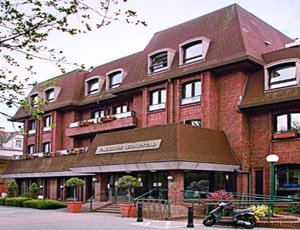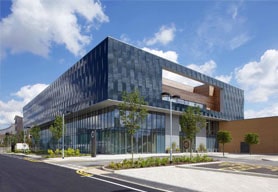The average cost of Tympanoplasty in London approximately starts from USD 4000
Treatment cost

Apart from in-detail treatment procedures available, Parkside Private Hospital located in London, United Kingdom has a wide variety of facilities available for International Patients. Some of the facilities which are provided by them are Accommodation, Airport Transfer, Choice of Meals, Interpreter, SIM, TV inside room. Also listed below are some of the most prominent infrastructural details:


Circle Reading Hospital is a multispecialty hospital located in Reading, Berkshire. The infrastructure of the hospital is such that the patient is exposed to the luxurious and friendly environment and not something that seems daunting to them. The hospital offers a wide range of diagnostic and treatment services circle Reading Hospital is a multispecialty hospital located in Reading, Berkshire. The infrastructure of the hospital is such that the patient is exposed to the luxurious and friendly environment and not something that seems daunting to them. The hospital offers a wide range of diagnostic and treatment services to its patients, allowing them to choose the services that they wish to avail themselves in a hassle-free manner.
Keeping the quality in mind that the patient demands, the hospital has associated itself with some of the best consultants from Berkshire. The presence of some of the most experienced specialists from varied backgrounds, allows the hospital to have an environment that ensures the best possible clinical care for the patients.
The hospital offers treatment across 15+ specialties and some of the most popular treatments are offered for hip, knee, back, foot & ankle, gastroenterology, gynecology, shoulder & elbow, and gastroenterology.
Circle Reading Hospital offers a very warm and comfortable environment to the patients, from the moment they enter the building, whether for consultation or inpatient stay.
Facilities Provided:
People from all age groups can be affected by ear disorders and hearing impairment problems. In the United States, a survey revealed that under the age of 65, over 60 percent of the population suffers from problems related to hearing loss. However, almost 25 percent of people aged above 65 experience a significant loss of hearing. Thankfully, different types of ENT surgeries are available to treat problems related to the ear.
Most often, people are diagnosed with problems related to the eardrum, or tympanum, and the infection in the cells of the mastoid bone. The tympanum is the thin membranous structure present between the outer and the middle ear. It vibrates when sound waves hit on it and this enables us to hear.
A repair surgery called tympanoplasty is required to treat a perforation or hole in the eardrum. The middle ear is sterile but due to rupture of the eardrum, an infection can also occur. It may also be required for repairing of tiny bones present behind the eardrum or ossicles in the mastoid bone. This repair is known as mastoidectomy.
Tympanoplasty and mastoidectomy are therefore conducted together in many cases. This procedure is known as tympano-mastoidectomy.
Several reasons may cause loss of hearing, including the following:
Birth defect
An ear infection that has grown very severe and left untreated for long
The injury suffered by the ear
Ear subjected to excessive levels of noise
Hearing loss as a result of age
Other reasons
Some of the common symptoms of a puncture in eardrum include the following:
Sharp pain in the ear that disappears abruptly
Excessive pressure, which will suddenly disappear with the rupture and pus formation in the ear
Loss of hearing
Dizziness
Type 1 tympanoplasty or myringoplasty is the surgery that ensures restoration of the eardrum that got perforated with drafting
Type II tympanoplasty addresses membrane perforations with erosion in the bone malleus. Grafting is done on the incus bone or in the remains of the malleus.
Type III tympanoplasty is meant for destruction of two ossicles and intact and mobile stapes bone. A graft is placed on the stapes and it provides protection for the total assembly.
Type IV tympanoplasty is useful for cases of ossicular destruction, which has all or part of the arch of stapes included. A graft is placed around the mobile stapes footplate
Type V tympanoplasty is useful when the footplate of the stapes bone is fixed.
For treating Cholesteatoma, tympanoplasty can be combined with stapedectomy and mastoidectomy and in many cases, a second operation is required to ensure the infection is totally eradicated.
The tympanoplasty surgery is performed with intravenous sedation and local anesthesia. An incision is made into the ear canal section and from the bony ear canal, the remaining eardrum is elevated and lifted forward. Under the operating microscope, the ear structures can be seen clearly. An incision behind the ear is made if the hole is very large or far forward. It ensures that the entire outer ear is forwarded, giving better access to the perforation.
The perforated remnant part is rotated forward after the hole is exposed and now the ossicles are inspected. Scar tissue and bands can surround the bones and they are removed with a laser or micro hooks. Now the ossicular chain is pressed to check its mobility and functionality. If it is found to be mobile, then the rest of the surgery aims at repairing the defect of the drum.
From the tragus, which is the cartilaginous lobe of skin in front of the ear, or from the back of the ear,
If the bones in the ear suffer from erosion, then ossicular reconstruction is advised. At times it can be determined before surgery but in other cases, erosion is visible only when the ear is completely opened under the microscope. The reconstruction can happen at the time of the eardrum construction. Bone erosion can happen at the tip of the incus or anvil. A discontinuity between the stapes and the incus has to be resolved.
A small piece of bone or cartilage can be inserted from some other part of the body of the patient if the gap between the two cones mentioned above is small. But if the gap is large, then the anvil bone is removed and remodeled to give a shape of a tooth with the help of the operating microscope. After reshaping the prosthesis, it is placed between the malleus and the stapes, and ossicular chain continuity is then re-established.
In some other ossicular construction, the malleus can get fixated by bony ingrowth or scar tissue to the ear’s lateral wall. The plastic-type or
Usually, a patient is discharged within two to three hours of the surgery. Along with a mild pain reliever, some antibiotics are also administered. After 10 days, the patient is again expected to visit so that packing can be removed and graft success can be checked.
Patients are advised to keep water away from the surgical site and avoid blowing of the nose. If the patient is suffering from cold and allergies, then decongestants are prescribed. Within 5 to 6 days, the patients can resume a normal life. After 3 weeks of the surgery, the packing is removed under the operating microscope and at this point, the grafting success can be completely determined.
Care must be taken by the patient to soak the ear canal with antibiotics to keep infection at bay. Shearing forces of excessive tension should not be felt by the graft. The surgeon will advise the patient to avoid activities that alter the tympanic pressure, including using a straw to drink or blowing of the nose. Finally, a hearing test is performed after 4 to 6 weeks of the surgery.
Ask your healthcare adviser for the best multiple options and choose the one that meets your expectations
The minimum cost of Tympanoplasty in London is about $4000. Tympanoplasty in London is available across many hospitals in different states.
Tympanoplasty cost in London varies from one hospital to the other. Some of the best hospitals for Tympanoplasty offer a comprehensive package that covers the end-to-end expenses related to investigations and treatment of the patient. The comprehensive Tympanoplasty package cost includes the cost of investigations, surgery, medicines and consumables. There are many things that may increase the cost of Tympanoplasty in London, including prolonged hospital stay and complications after the procedure.
Many hospitals in London perform Tympanoplasty. Some of the most renowned hospitals for Tympanoplasty in London include the following:
After discharge from the hospital, the patient has to stay for another 8 days in the country for complete recovery. This duration of stay is recommended to complete all the necessary follow-ups and control tests to ensure that the surgery was successful.
London is considered to be one of the best places for Tympanoplasty in the world. This is because of the availability of some of the best doctors, advanced medical technology and good hospital infrastructure. However, some of the other popular destinations for Tympanoplasty include the following:
Apart from the Tympanoplasty cost, the patient may have to pay for additional daily expenses such as for guest house after discharge and meals. These are the chanrges for daily meals and hotel stay outside the hospital. The extra charges may vary from 55 USD.
The patient has to spend about 2 Days in the hospital after Tympanoplasty for proper recovery and to get clearance for discharge. The doctors team review the patient's recovery during this time with the help of blood tests and imaging scans. Once they feel that everything is on track, the patient is discharged.
There are about 1 Hospitals in London that offer Tympanoplasty to international patients. These hospitals have the required infrastructure and a decided Tympanoplasty unit where renal failure patients can be treated. Apart from good services, the hospitals are known to follow all standard and legal guidelines as dictated by the local medical affairs body or organization.
Some of the most sought after doctors for Tympanoplasty in London are: